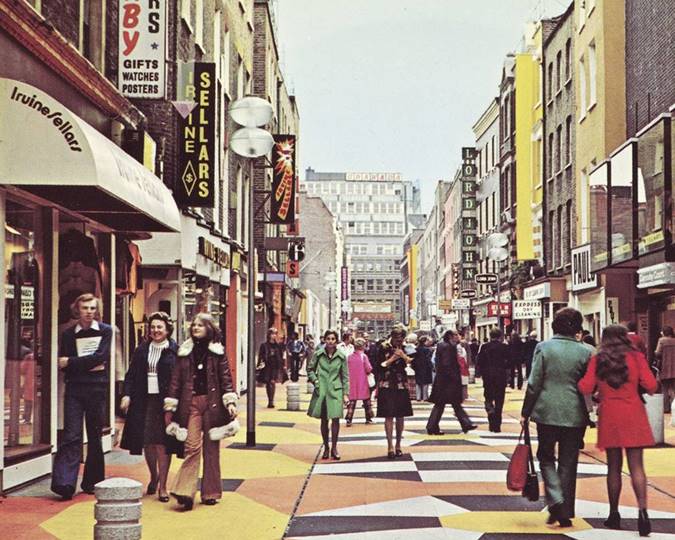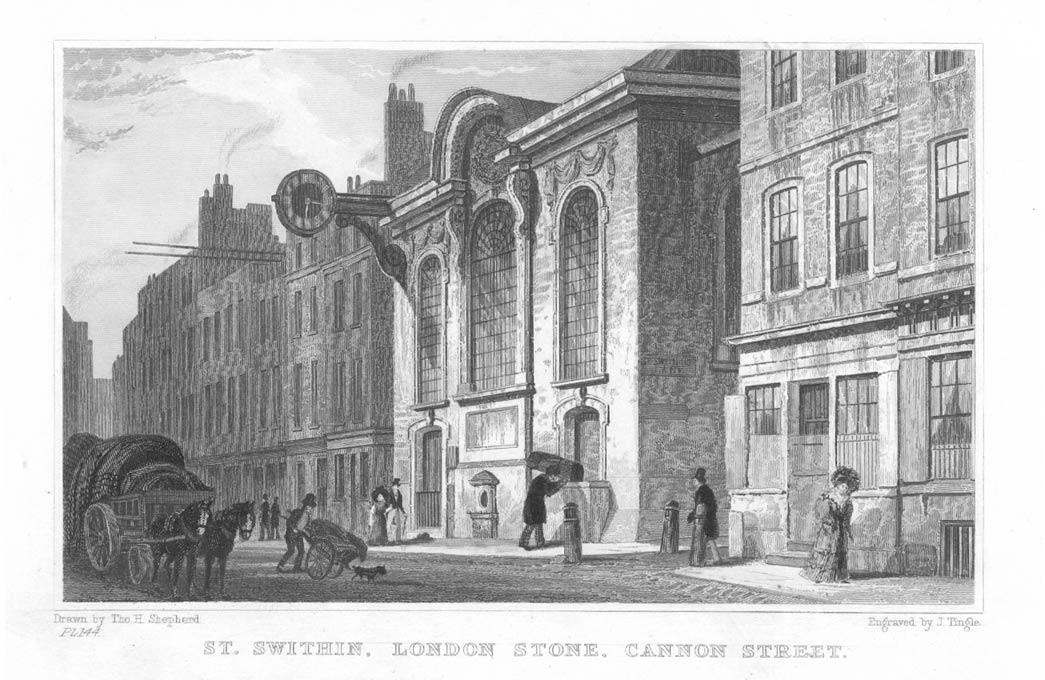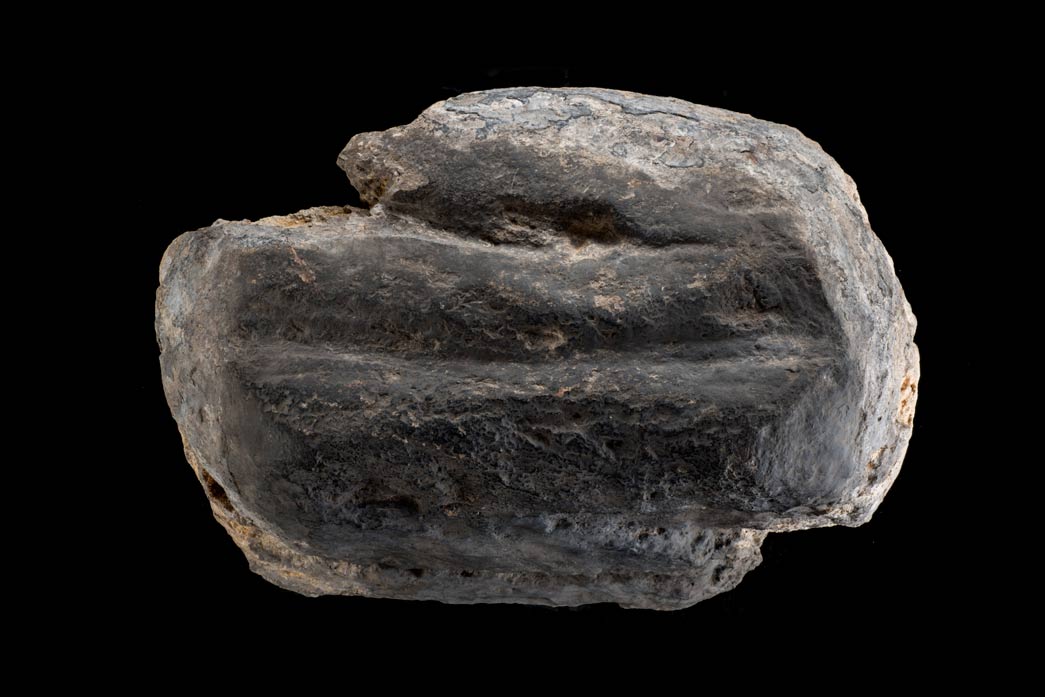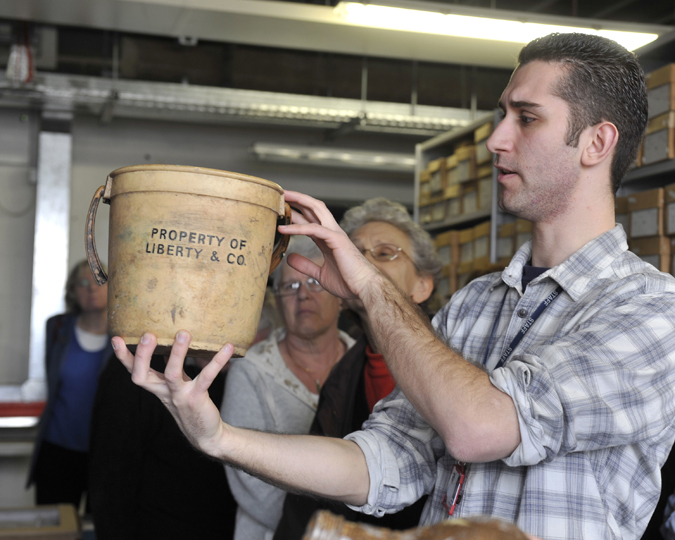It’s been claimed to be a Druidic altar, a Roman milestone, and the magical ‘heart of London’. It’s one of London’s most ancient landmarks, but most people have never heard of it – or if they have, they’ve heard one of the strange legends that have sprouted up around it. Curator Emeritus John Clark (formerly curator of the Museum of London’s medieval collections) examines the myths and the colourful cast of characters who created them, from William Blake to an eccentric Welsh priest.
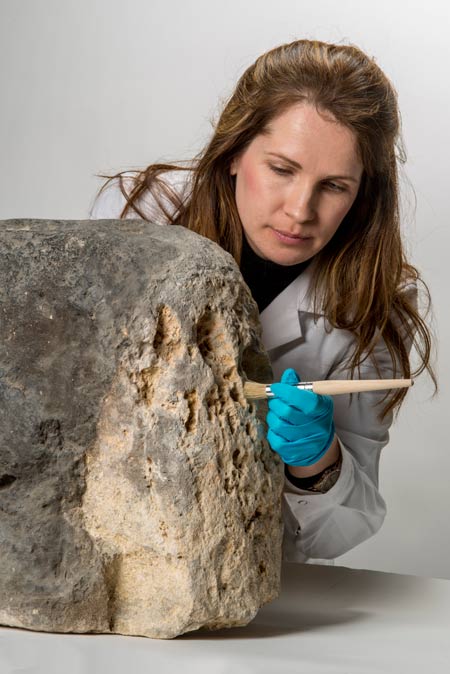
Conserving the Stone
Archaeological conservator Helen Butler readies London Stone for display at the museum.
Today, all that is left of once-famous London Stone is a
block of limestone, currently resting in a glass case in the Museum of London.
It had sat for years behind an iron grille in the wall of 111 Cannon Street, a
dilapidated 1960s office building now being demolished. There a bronze plaque informed
the passer-by that ‘Its origin and purpose are unknown’. Its origin is indeed
mysterious, and whenever development of the site was proposed, the media worked
up the mystery – not forgetting to mention the ‘belief’ that if the stone was
moved or destroyed, the future of London itself would be jeopardized.
However, much of what we think we know about London Stone is untrue, or at best is guesswork unsupported by any evidence.
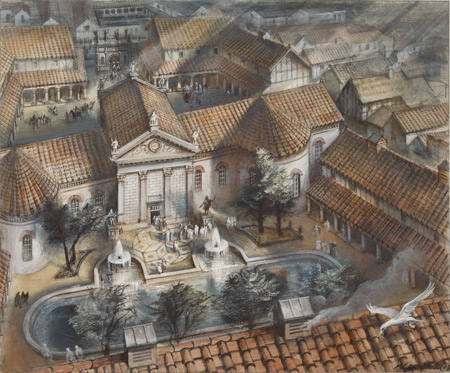
Artist's reconstruction of the Roman governor's palace
Excavated on Cannon Street. Painting by Alan Sorrell.
Myth 1: It has stood
in London since prehistoric times
The stone itself is oolitic limestone, of a type first brought to London for building and sculptural purposes in the Roman period – but also used in Saxon and medieval times. It originally stood towards the southern edge of the medieval Candlewick Street (now Cannon Street) opposite St Swithin’s church (called ‘St Swithin at London Stone’ by at least 1557). This would have placed it in front of the great Roman building, often identified as the provincial governor’s palace, that stood on the site now occupied by Cannon Street station. It has been suggested that the Stone was originally some sort of monument erected in the palace forecourt. Some have described it - without any evidence - as being a Roman ‘milliarium’, the central milestone from which distances in the Roman province of Britain were measured.
On the other hand, it also stands at the centre of the grid of new streets laid out after King Alfred re-established London in 886, after Viking attacks had destroyed the original Saxon town, so it may have served some significant function for late Saxon Londoners. And it must be at this period that it received its singular name – ‘Lundene Stane’ in Old English.
Myth 2: It was an ancient altar used for Druidic sacrifices
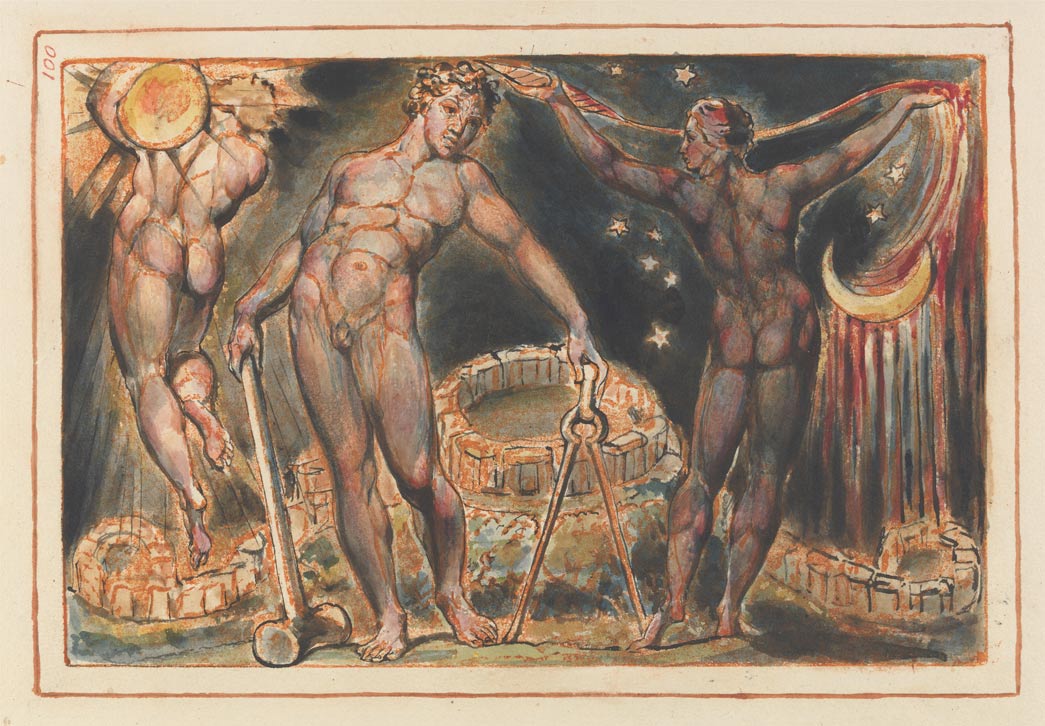
Jerusalem: The Emanation of the Giant Albion, by William Blake, 1804-20
Collection of the Yale Center for British Art.
John Strype, in his 1720 updated edition of John Stow’s Survey of London, seems to have been the first to offer the proposal that London Stone was ‘an Object, or Monument, of Heathen Worship’ erected by the Druids. Thus, later, London Stone was to play an important but not always consistent role in the visionary works of William Blake, prominent among them being its identification as an altar stone upon which Druids carried out bloody sacrifices.
Where Albion slept beneath the Fatal Tree,
And the Druids’ golden Knife
Rioted in human gore, In Offerings of Human Life…
They groan’d aloud on London Stone,
They groan’d aloud on Tyburn’s Brook…
(Jerusalem, plate 27 ‘To the Jews’)
There is no evidence for this, and London Stone, whatever its purpose, was certainly not erected before the Roman period.
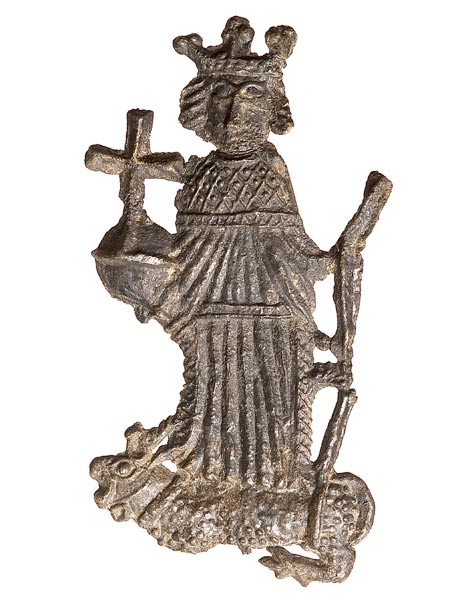
Pilgrim badge depicting Henry VI, late 15th century
The monarch who Jack Cade rebelled against. ID no. 85.79/6
Myth 3: Medieval kings
and queens would visit the Stone to ceremonially take control of London
London Stone entered national history briefly in the summer of 1450, when John or Jack Cade, leader of the Kentish rebellion against the corrupt government of Henry VI, entered London and, striking London Stone with his sword, claimed to be ‘lord of this city’. There is no recorded precedent for his action, and contemporary chroniclers were at a loss as to its significance. Accounts even differ as to when it occurred – when Cade first entered the city on Friday 3 July, or the following day. Unfortunately we know the story best from Shakespeare’s Henry VI Part 2 – in which Cade seats himself on the stone as on a throne, issues proclamations, and passes swift judgement on the first unfortunate man to offend him. This is great theatre; it is also fiction – but it has led to the belief that London Stone was traditionally used for such purposes. Shakespeare’s inventive genius has a lot to answer for.
Myth 4: London Stone has never (until now!) been moved from its resting place
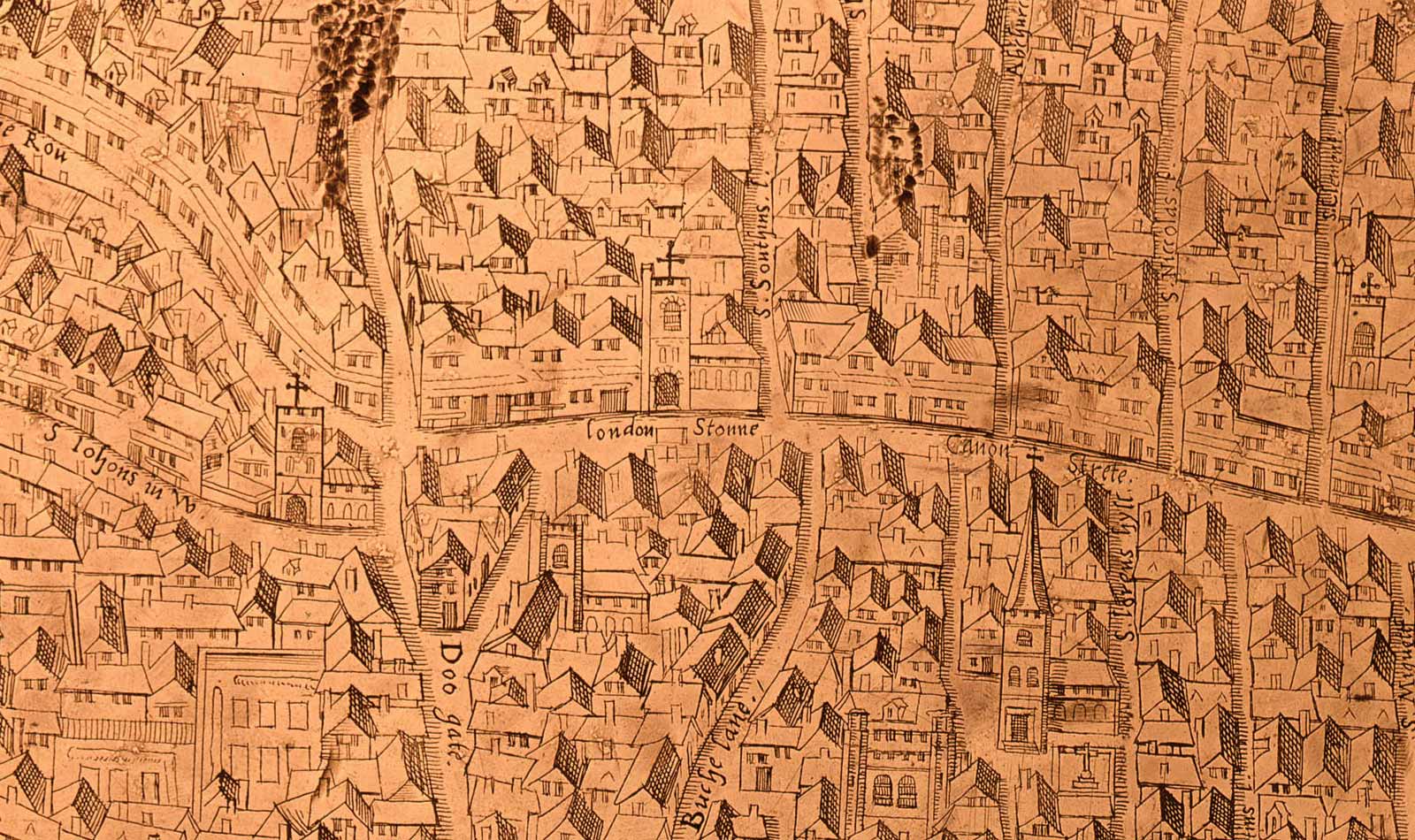
The London Stone shown on the first detailed map of London, 1559
Detail from copper printing plate; ID no. 85.471
The current temporary shift to the Museum of London is nothing new – the Stone has been surprisingly migratory in the last few hundred years. It originally stood in Candlewick Street (Cannon Street) on the south side near the gutter, facing the door of St Swithin’s church on the north side of the street.
It seems to have been damaged by the Great Fire of 1666, which destroyed all the surrounding buildings. By 1720 what was left of the stone was protected by a small stone cupola built over it, and in 1742 it was moved as a traffic hazard, to be placed, still within its protective cupola, on the north side of the street against the door of the new Wren church of St Swithin. Two further moves, in 1798 and in the 1820s, placed it eventually where it was to remain for more than 100 years, built into the middle of the church’s south wall.
The Wren church was gutted by bombing in the Second World War, but the walls were left standing and London Stone remained in place until 1960, when it was moved to the then Guildhall Museum (at that time housed in the Royal Exchange) for safekeeping. After the demolition of the ruins and the completion of the new building on the site to house the Bank of China, in October 1962 the Stone was placed in the specially constructed grilled and glazed alcove in the wall that it occupied until recently.
Myth 5: If the Stone
is moved or destroyed, London will fall
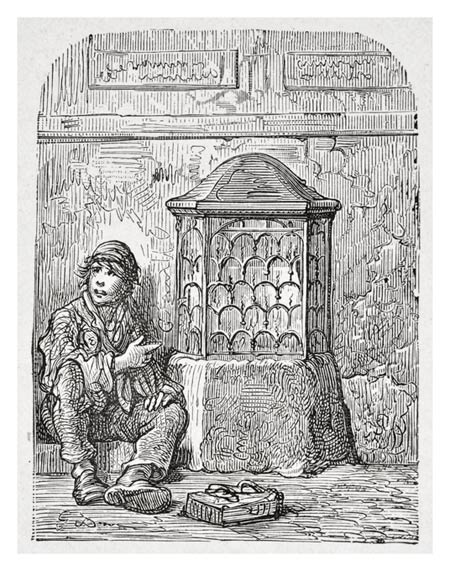
Illustration of the London Stone from 'London: a Pilgrimage'
Blanchard Jerrold and Gustave Doré, 1872; ID no. NN23607(12).
By the end of the 18th century romantic writers were
beginning to suggest a relationship between the survival of London Stone and
the well-being of London itself. This recalled the legendary ‘palladium’ of
Greek mythology, the statue of Pallas Athene that protected the city of Troy.
So Thomas Pennant, in a history of London published in the 1790s, commented ‘it
seems preserved like the Palladium of the city…’.
This concept received a great boost from the apparent
discovery of an ‘ancient saying’ – ‘So long as the Stone of Brutus is safe, so
long will London flourish’. This first appeared in print in an article in the
periodical Notes and Queries in 1862
– apparently no previous writer was aware of it. Where did this ‘ancient saying’
come from, and why had it been forgotten until 1862? And why ‘the Stone of
Brutus’?
The article retails a supposed legend that London Stone was set
up by Brutus of Troy, the first king of Britain. This notion is rooted in a
much older piece of made-up history: the legend that London was first founded by
Brutus, leader of a group of Trojan colonists, as Troia Nova, or ‘New Troy’.
This story derived ultimately from the 12th-century History of the Kings of Britain by Geoffrey of Monmouth, a pseudo-historian
and arch-inventor of legends. The author of the Notes and Queries article claims that Brutus had brought the base
of the original statue of Pallas Athena from Troy and erected it as an altar in
a temple of Diana in ‘New Troy’, and that the ancient kings of Britain had
sworn their oaths upon it. Again, no other writer had claimed to know this tradition.
The article was written (under a pseudonym) by the Revd Richard Williams Morgan, Anglican priest, Welsh patriot, bard, and later the founder of his own Ancient British Church. For Morgan the Welsh, who were superior to the English in every way, were directly descended from Brutus and the Trojan immigrants. There can be no doubt that the idea that legendary Brutus brought the Stone from Troy and the saying about London’s fate if the Stone is lost or damaged are both his own inventions. Sadly, Morgan’s fantasy is still quoted as if it were an authentic ’medieval proverb’.
Myth 6: The Stone has been protected by a long line of guardians
A modern myth has arisen that the Lord Mayor of London serves as a ‘custodian’ or ‘guardian of the Stone’. It is an obvious concept, but belief in a guardian of London Stone does not seem ever to have existed in historical times, nor does the Corporation of the City of London list it as one of the Lord Mayor’s official duties. In fact, until 1972, when London Stone was officially Listed (Grade II*) as a structure of special historic interest, neither the Corporation nor the Lord Mayor seems to have taken any responsibility for the Stone. Ownership of the Stone itself has meanwhile passed with ownership of the land on which it has stood for nearly 300 years, the site of St Swithin’s church.
But in May 2006, a BBC reporter identified the manager of the Sportec sports shop, that then occupied the building in which the Stone was housed, as its custodian. The manager, Chris Cheek, was said to enjoy the idea that he was ‘the latest in a long line of people to be in charge of something so mysterious and ancient’. It is not recorded if the responsibility passed to the manager of the branch of W H Smith that later occupied the building.
Myth 7: London Stone
is the magical heart of London
In the late 19th century the folklorist George Laurence Gomme put forward his opinion that London Stone was London’s ‘fetish stone’: ‘In early Aryan days, when a village was first established, a stone was set up. To this stone the head man of the village made an offering once a year.’ The Lord Mayor was therefore the lineal descendant of the first ‘village head man’ of London – see Myth 6. This authoritative statement by a well-respected folklorist had a great influence on other writers. In 1937 another folklorist, Lewis Spence, published a book on Legendary London, in which he claimed the ‘Brutus’ legend as a traditional memory of actual historic events. Authors interested in geomancy (the magic of the landscape) have identified the Stone as a ‘mark stone’ on several leylines. Others fear its removal from its original location has violated the integrity of the City’s sacred geometry.
These ideas have inspired episodes in several recent urban fantasy novels – stories with supernatural elements set in real-world urban environments – from Charlie Fletcher’s Stoneheart trilogy to Kate Griffin’s The Midnight Mayor. In the novel Kraken, by award-winning author China Miéville, London Stone is ‘the beating heart of London’, guarded by a cabal of ‘Londonmancers’.
What can we learn from these myths?
An admission that we don’t know the origin of London Stone (and probably never will) satisfies nobody – hence the apparent desire for a mythology that lends it great antiquity and an even greater symbolic role.
The significance of London Stone, and the importance of taking measures for its preservation, depend not only on its actual age and origins, but on the reputation it has acquired over the years since.
London Stone is a myth.
For further details of the history and mythology of London Stone see the following articles, which give full references to all the sources cited here:
John Clark ‘Jack Cade at London Stone’ in Transactions of London and Middlesex Archaeological Society 58 (2007) 169-89
John Clark ‘London Stone: Stone of Brutus or fetish stone – making the myth’ in Folklore 121:1 (2010) 38-60
Want to get updates about the city's buried past straight to your inbox? Sign up for our Archaeology newsletter to find out about upcoming exhibitions, events and articles.



